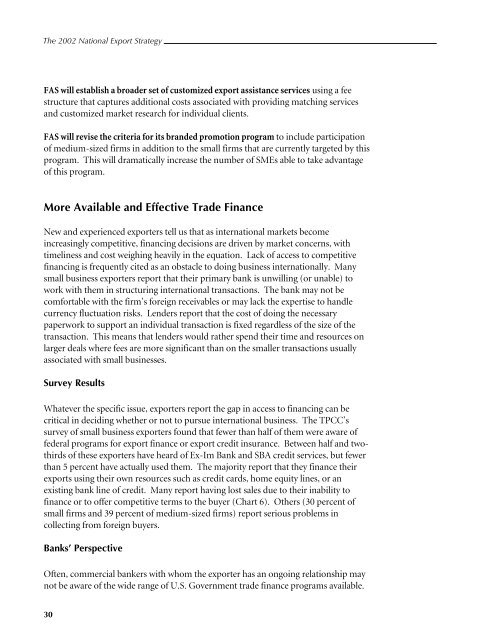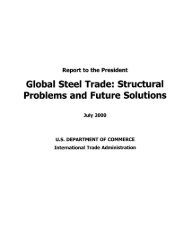National Export Strategy 2002 - International Trade Administration ...
National Export Strategy 2002 - International Trade Administration ...
National Export Strategy 2002 - International Trade Administration ...
You also want an ePaper? Increase the reach of your titles
YUMPU automatically turns print PDFs into web optimized ePapers that Google loves.
The <strong>2002</strong> <strong>National</strong> <strong>Export</strong> <strong>Strategy</strong><br />
FAS will establish a broader set of customized export assistance services using a fee<br />
structure that captures additional costs associated with providing matching services<br />
and customized market research for individual clients.<br />
FAS will revise the criteria for its branded promotion program to include participation<br />
of medium-sized firms in addition to the small firms that are currently targeted by this<br />
program. This will dramatically increase the number of SMEs able to take advantage<br />
of this program.<br />
More Available and Effective <strong>Trade</strong> Finance<br />
New and experienced exporters tell us that as international markets become<br />
increasingly competitive, financing decisions are driven by market concerns, with<br />
timeliness and cost weighing heavily in the equation. Lack of access to competitive<br />
financing is frequently cited as an obstacle to doing business internationally. Many<br />
small business exporters report that their primary bank is unwilling (or unable) to<br />
work with them in structuring international transactions. The bank may not be<br />
comfortable with the firm’s foreign receivables or may lack the expertise to handle<br />
currency fluctuation risks. Lenders report that the cost of doing the necessary<br />
paperwork to support an individual transaction is fixed regardless of the size of the<br />
transaction. This means that lenders would rather spend their time and resources on<br />
larger deals where fees are more significant than on the smaller transactions usually<br />
associated with small businesses.<br />
Survey Results<br />
Whatever the specific issue, exporters report the gap in access to financing can be<br />
critical in deciding whether or not to pursue international business. The TPCC’s<br />
survey of small business exporters found that fewer than half of them were aware of<br />
federal programs for export finance or export credit insurance. Between half and twothirds<br />
of these exporters have heard of Ex-Im Bank and SBA credit services, but fewer<br />
than 5 percent have actually used them. The majority report that they finance their<br />
exports using their own resources such as credit cards, home equity lines, or an<br />
existing bank line of credit. Many report having lost sales due to their inability to<br />
finance or to offer competitive terms to the buyer (Chart 6). Others (30 percent of<br />
small firms and 39 percent of medium-sized firms) report serious problems in<br />
collecting from foreign buyers.<br />
Banks’ Perspective<br />
Often, commercial bankers with whom the exporter has an ongoing relationship may<br />
not be aware of the wide range of U.S. Government trade finance programs available.<br />
30
















